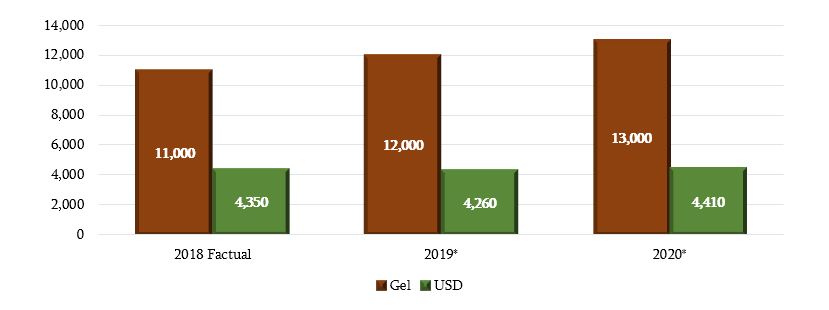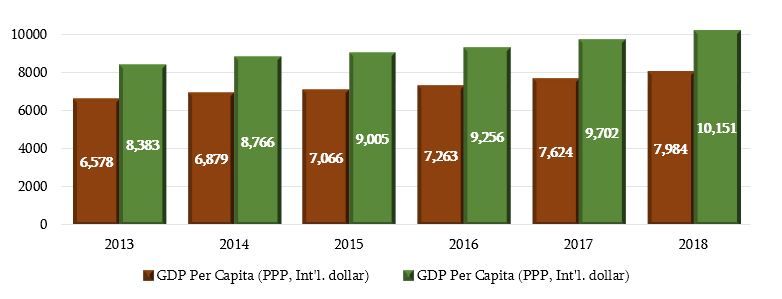Resume: In 2018, the GDP per capita in USD was 4,345 and will be USD 4,260 and USD 4,410 according to 2019 and 2020 estimates, respectively. However, of note is that the aforementioned decrease in the GDP is related to the depreciation of the GEL exchange rate vis-à-vis USD. In 2019, the GEL reached a historic peak of depreciation which naturally resulted in a decrease of USD denominated figures. The depreciation of the national currency exchange rate entails certain negative consequences. Among these consequences are an increased debt service burden for those who have income in GEL and obligations in a foreign currency as well as making travel abroad and import more expensive. However, whilst analysing the population’s income dynamic, converting to USD is groundless since GEL is the only legal tender in Georgia, the population’s expenses are mostly denominated in GEL and the growth of expenses as a result of changes in the exchange rate is reflected in the inflation rate. Therefore, the real GDP, which is free from price changes and indicates real added value, is the accepted as the best indicator to analyse a country’s GDP in time.
In order to analyse the population’s income dynamic, it is appropriate to discuss the real[1] GDP per capita. In addition, as mentioned by Giorgi Kakauridze, the population’s real income dynamic can be analysed in international dollars, according to purchasing power parity (PPP), which is also a correct statement although using that indicator is more relevant for comparison with other countries. Both the real GDP and the GDP PPP in 2013-2018 have increased and it is expected to have a real economic growth in 2019-2020. Therefore, the statement about a decrease of real income in general is irrelevant.
Analysis
Davit Chichinadze, MP, and Giorgi Kakauridze, Deputy Minister of Finance, had a discussion at the sitting of the Budget and Finance Committee of the Parliament of Georgia. Davit Chichinadze stated: “In 2019, you cannot increase the GDP per capita and the GDP per capita in USD is decreased. Are you trying to say that even as compared to 2013, taken the GEL of that time and the GEL of today, life has advanced?” Giorgi Kakauridze’s counter-argument was: “The 2018 GDP is calculated on a different exchange rate and the 2019 GDP also on a different one. We have growth in 2020. There are two types of indicators in USD. One nominal indicator expressed in USD and the other indicator expressed in international dollar purchasing power where we have annual growth.”
The gross domestic product (GDP) shows the total volume of goods and services produced for a certain period of time in a country for final consumption which measures the size and the scale of a country’s economy. The GDP per capita is one of the indicators of quality of life in a country.
The data, which are disputed by the politicians, are given in the 2020 budget’s Basic Economic and Financial Indicators document. The GDP per capita in GEL and in USD, 2018’s factual data and estimates for 2019-2020 are given in Graph 1.
Graph 1: 2018 Factual GDP Per Capita and Estimates for 2019-2020 (Thousand)

Source: Ministry of Finance of Georgia
The depreciation of the national currency exchange rate entails certain negative consequences. Among these consequences are increased debt service burden for those who have income in GEL and obligations in a foreign currency as well as making travel abroad and import more expensive. However, an analysis of the population’s income dynamic does not warrant converting to USD since GEL is the only legal tender in Georgia and the population’s expenses are mostly denominated in GEL .
In order to analyse the population’s income dynamic, it is appropriate to discuss the real[1] GDP per capita which is adjusted to price level change (in turn, price level change incorporates the impact of change in the exchange rate). In addition, as mentioned by Giorgi Kakauridze, the population’s real income dynamic can be analysed in international dollars according to purchasing power parity (PPP). This approach (PPP) envisions that currencies have different purchasing power in different countries of the world. Production prices are lower in low-income countries whilst a currency’s purchasing power is higher (it is possible to purchase more product with USD 1).
Graph 2: Real GDP (Per Capita) and PPP International Dollars Dynamic in 2013-2018

Source: National Statistics Office of Georgia
Both the real GDP and the one expressed is PPP international dollars was growing in 2013-2018. In addition, real economic growth is expected in 2019-2022. Therefore, statements about a decrease of incomes in general are irrelevant.








